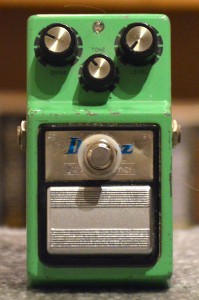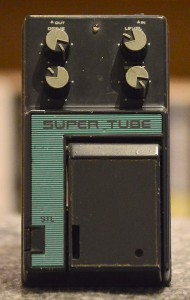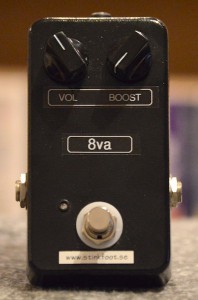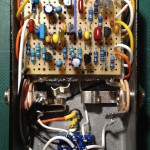Ibanez TS-9 Tube Screamer
Early 80s version. I found it in the “trash” corner of a rehearsal room, all busted up with no bottom plate and a big crack down the middle of the pcb. I asked around if anyone wanted it, and the general consensus was: “Nope. It’s busted. It’s a throwaway.” So I took it home and gave it some TLC – I repaired the cracked traces, installed a new battery clip and manufactured a new bottom plate from a piece of cardboard. To my amazement, it worked! I used it at every gig for a good 10-12 years, and eventually upgraded the bottom plate to a real Ibanez item (I stole the bottom plate from a PT-9 Phaser I wasn’t using). I also modified the output section to 808 specs and let more bass into the circuit. Stock tube screamers seems to beg you to turn them up real loud – to get some bottom end out of it – but this one sounds fuller from the get-go. In a later modding session I also replaced the JRC 2043 chip it came with for a reissue JRC4558D, and it made the pedal just that little bit better. With the RC4558P the pedal becomes just a hair raunchier, and I ended up preferring the slightly smoother sounding JRC4558D. Later, I also damaged what little vintage value it had by installing a proper stompswitch in the nameplate, wired for true bypass. So sue me… 😉
Ibanez STL Super Tube
After having the opportunity to work on one of these pedals – I replaced a broken drive pot and got to mess about with some circuit modifications as well – I immediately decided to buy one for myself. The one I have was a little busted up – the switch needed a good cleaning, and the rubber part of the battery lid/footpedal was long gone. But it sounds really cool… It is more or less a tube screamer, but with an added post distortion mid-boost circuit. I found that with the ”bite” control (er, the mid boost, that is) almost fully off, you get a fairly normal tube screamer sound, but with slightly more gain and less mids than a TS-9. Just the ticket… I did some mods to it – more gain (about 1.5 times) with extended pot range, better low end etc – and it sounds great! I found that I needed to run the ”bright” control fully up to get the right amount of top end, while the ”bite” control hovered around 10 o’clock, for slightly less mids than a TS-9 would have.
Mooer Black Secret

Yes, a Chinese made cheapo pedal… I recently (april 2013) had the opportunity to test a section of the Mooer Micro series line, and found them to be a little hit-and-miss. Some were good, others downright awful with a few real gems thrown in. The Black Secret is one of the good ’uns (in my opinion). It is basically a circuit copy of a RAT, with an additional switch to select the Turbo RAT mode (LED clipping diodes, for a harder, louder sound). I use it on the ”vintage” setting with the gain around 1 o’clock and the Filter knob fairly high. It sounds really good as a medium/high gain (high gain for me, that is) dirt pedal, and is one of the Mooers I’d definitely recommend.
The only thing I don’t like is the splatty compression that sometimes rears its head. It happens when I play hard on the lower strings with the bridge pickup engaged – it’s almost as if the whole pedal gets overwhelmed when the input signal gets too strong. It doesn’t seem to be the clipping diodes that goes ”splat” (it’s the same in the ”turbo” setting, which has LED clippers), but rather the op-amp itself. This seems to be a feature of the RAT as well, so I’m not arguing that the Mooer is worse. I just don’t like it, so the pedal stays in storage.
Mooer Solo Distortion

Allegedly a clone of the Suhr Riot. I can’t say if that’s true or not, and – if it’s meant to be a clone – how close it is circuit-wise. Personally, I suspect I’ll eventually end up with a Riot sooner or later. But in the mean time, this is a really good pedal in its own right. Fat and snappy, yet creamy with plenty of sustain and just the right amount of mids and low end. Not too much, not too little (both of which are very common with distortion pedals). The mode switch does make some difference, but it’s quite subtle. The ”Natural” and ”Classic” settings are quite similar – the main difference seems to be that there’s some LED clipping going on in the Classic mode, and also a slight shift in the upper midrange. The ”Tight” setting is indeed a tad… um… tighter. It’s also a hair louder (which might explain why I initially thought it sounded better than the other two). But again, these differences are subtle – which might mean they can come in handy when playing live (when you often need ”just a touch” more or less of something). But it can also mean that it’s only in a live band setting that you can definitely determine which setting works best.
I ordered this one from Prymaxe Vintage in the US. I chose the cheapest shipping option, and they arrived in good time right to my mailbox. As I have done with the other Mooer pedals, I’ve added some white-out to the small knobs, to make it easier to read the settings. Newer Mooers already come with this feature, but if you find an older one, it is quite easy to do.
Electro-Harmonix Big Muff pi

1978 op-amp version. Another thrash bin find from yet another rehearsal room. When I got it, it was opened and had an adapter for a Texas Instruments calculator hard soldered to the “ac input” jack… After a long, hard look I noticed other oddities as well. The stereo input jack had a ground cable attached – to the ”ring” lug. The ”sleeve” lug had never been touched. Also, a black wire (”ground” in universal electronics language) from the ”ac input jack” was soldered to the power input of the pcb… I removed the ac jack (which actually should be called a ”DC jack”, since it is meant for a DC voltage) and installed a battery clip instead, using the input jack for power on/off. After a bit of tinkering, it worked just fine. It doesn’t clean up as well as a germanium fuzz, but then again it’s a completely different design. Three gain stages from two op-amp stages (half a 4558 and a 741) and six(!) clipping diodes…
Now what was that fuzz (sorry) about the op-amps? Well, apparently Electro-Harmonix did some experimenting with a new design that replaced the four transistors with an op-amp based circuit, with an input buffer stage that they wisely left in the bypass path as well (far better than the ”hardwire” split bypass method that was the norm back then). According to most knowledgeable people this version appeared in 1978, but I’ve also heard later dates being thrown around (apparently someone has an op-amp BM with 1982 pots). The pots in my Big Muff are dated late ’77 to early ’78, which gives some support to the claim that the op-amp era indeed happened in 1978. The experiment didn’t last long, in any case – EHX soon went back to the earlier four-transistor layout. Weirdly, even though the short production span makes it a somewhat rare beast, it is one of the more commonly seen vintage Big Muffs for sale…
Stinkfoot Octavia clone
I built this pedal using the Tetavia ready-to-solder circuit board from Tonepad.com. I already had most of the components (including the transformer), so it was just a matter of putting it together. Due to the relative weight of the transformer, I ended up fixing the circuit board to the box inside, rather than seat it on top of the pots. That meant I had to move the jacks and switch down, leaving no room for a battery. In hindsight, that may not have been the smartest move, since it’s the type of pedal I may end up bringing to choice gigs, rather than have it as a permanent fixture on the board. And being positive ground, it needs a separate/isolated power source. Oh well – a battery clip and DC plug later, I had it up and running 🙂
The Octavia is a really cool effect, but hard to master. I mainly run it with the boost low, and if I want that searing octave fuzz tone I kick in an overdrive after it. Not the most commonly used sound for me, but it has its place. And yes, I know there is another page where ”octave” pedals are listed. However, this one is just as much a fuzz, so it ended up here 🙂
Stinkfoot ”30”

After having played many years with the Tube Screamer/Fender amp sound for light overdrive, the Eleven Rack steered me more into the AC30 direction (in that setup, I use a simulated AC30 for my low-gain dirt). And naturally, I wanted to move more towards that tone with my pedalboard setup as well. I looked around, and the Catalinbread CB30 caught my eye. It was part of their ”Foundation” series, where they bring in elements of various classic amps in a stompbox format. They are not modellers, and don’t have any speaker simulation going on – they’re meant to plug into your guitar amp, and make it sound like a Marshall/Hiwatt/Vox/Tweed Fender etc. Look them up at www.catalinbread.com!
I found a veroboard layout by IvIark on the web, built it up, and it sounds great! Just the right amount of grit and sustain, with that sligthly snarly cranked AC30 tone. I don’t think I lucked out either – I’m fairly sure the real deal from Catalinbread sounds even better. With my build, I found that I had to wind the gain up to max to produce the amount of dirt the real pedal does at 12 o’clock, and running the gain knob at minimum for a Vox-type clean sound like they do in the demo video didn’t work with mine. It just didn’t have enough gain, so a spot of tweaking ensued. Now it’s in the gain range where I want it, with enough output volume to make up for the lower gain settings. It’s still not 100% of the original pedal – it seems to have a larger gain range (clean to quite heavily dirty) with even more output – but it’s enough for my needs. I’d love to buy the real deal from Catalinbread, but as it happens they have discontinued the CB30. The closest thing they have is probably the Galileo, which is meant to sound like an AC30 with a treble booster driving it. Instant Brian May 🙂
Boss DS-1 Distortion 40th Anniversary
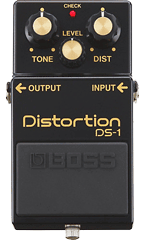
Used as a guinea pig/testbed for a possible new DS-1 mod. I wrote a post about the new DS-1(B) version that has been completely redesigned (check it out here), and wanted to get my hands on one of the more mod-friendly DS-1(A) variants to mess around with. Of course I could have bought a used one, and my local shop also had the regular orange one in stock. But when I could have the 40th Anniversary version, why not?
So what’s wrong with it, then? After all, seeing as it has been around for 40 years, it could be argued that it’s just fine as is. And in a sense, it is. For boosting Marshalls, the DS-1 has been a staple for ages. But when used as a pure distortion pedal – providing the main distortion with a clean amp – its drawbacks start to emerge. The midrange is too scooped – especially with Fender style amps – and the gain structure is a little weird. Yes, you can use the ”dist” knob to set the amount of dirt, but it really only goes from ”quite a bit” to ”very much”. Even with the distortion control set to zero, there’s still a lot of clipping going on. So a fresh new mod would have to address those points, to begin with. Time will tell, as always 🙂
